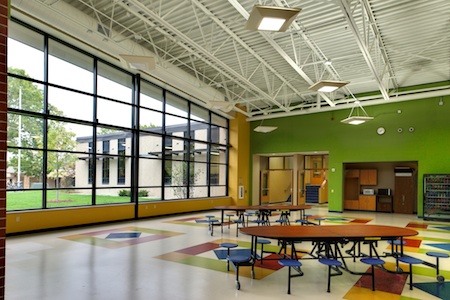Middle School Ranks Among Wisconsin’s Greenest

LAKE MILLS, Wis. – The middle school renovation and expansion at Lake Mills school district was recently awarded LEED Platinum, earning 58 out of 80 possible points.
The 36,632-square-foot renovation and 59,865-square-foot expansion at the school was built by Neenah, Wis.-based Miron Construction Co. according to the LEED for Schools program, which takes into account classroom acoustics, master planning, mold prevention, community space sharing and indoor quality, among other factors that "directly affect the health and well-being of children," according to the United States Green Building Council.
The school earned the certification for energy use, lighting, water and material use, along with incorporating the sustainable strategies into the classroom curriculum.
"The Lake Mills Middle School project efficiently uses our natural resources and makes an immediate, positive impact on our planet, which will tremendously benefit future generations to come," he said council founder and president Rick Fedrizzi.
Dean Sanders, Lake Mills’ district administrator, said the students have taken a great deal of pride in understanding how sustainability was integrated into the building.
"Teachers talk about how much quieter the building is, making it much easier to communicate with students," he said. "Many have commented on the significantly reduced respiratory illnesses and no longer need to take asthma or allergy medication."
The school’s total annual energy savings of $85,000 was a result of a high-efficiency building envelope, energy efficient lighting and controls system, and a geothermal heating and cooling system, according to company officials.
The school also added windows to increase day lighting and exterior sun shelves to reduce heat gain and glare.
Through the energy saving efforts, the school was able to return about $700,000 to taxpayers, according to the officials from the construction company.
The ventilation system is filtered by MERV filtration, which is designed to contribute to high indoor air quality and enhance the health and well-being of the staff and students, according to Theresa Lehman, director of sustainable services for Miron Construction, who served as the LEED project administrator.
The building was constructed with low emitting materials to further enhance air quality, and acoustically modeled for communication between the staff, students and the natural environment.
Company officials said 63 percent of the materials were regionally harvested and manufactured, and more than 68 percent of the wood bought for the facility was certified by the Forest Stewardship Council.
The district was able to reuse and refurbish existing classroom furniture, which saved thousands of dollars that went toward an underground stormwater retention system and window wells in the lower-level classrooms that originally had no natural daylight, officials said.
Vegetation and bioswales were also added to create an outdoor classroom, providing hands-on teaching opportunities on biodiversity and ecology.
Planting native vegetation and "low-mow" grasses eliminated the need for irrigation systems and low-flow plumbing fixtures were installed, resulting in a 42 percent decrease in water usage compared to a code-compliant school, officials reported.
Miron superintendent Jay Kuhlman implemented a construction indoor air quality plan and a construction waste management plan that resulted in diverting 77 percent of waste from the landfill, reintroducing the construction materials into the manufacturing process.
"The project drivers included teacher interaction, unique learning spaces, improved accessibility, connection to the neighborhood, cost efficiency, replacement of outdated and inefficient systems with high efficient systems, and integrating sustainable features," said Greg Douglas, vice president of design-build services for Miron Construction.
